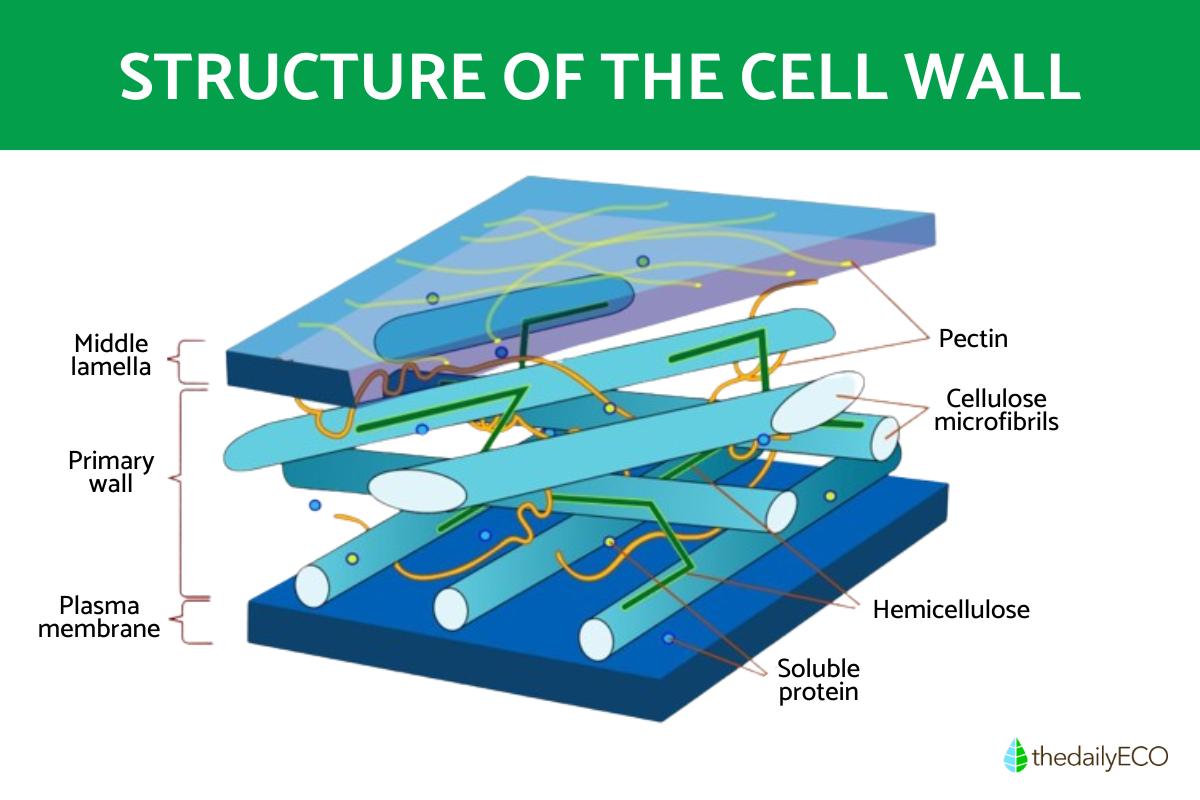What Is Cell Wall and Its Function?


Unlike animal cells, plant cells wear a sturdy exoskeleton - the cell wall! This essential structure is more than just a protective shell. It provides crucial support, safeguards the cell's interior, and even plays a role in regulating growth and nutrient exchange. Made primarily of cellulose, a complex sugar, the cell wall is a marvel of engineering in the plant kingdom.
In this article by thedailyECO, we'll explore what cell walls are, their functions, structure, and how they contribute to the strength and resilience of plants.
What is the cell wall?
The cell wall, a defining feature of plant cells, sets them apart from their animal counterparts, which rely on a more flexible structure called the plasma membrane.
This rigid extracellular matrix, essentially the non-living scaffold surrounding the cell, is primarily made of cellulose, a complex sugar that gives plant cells their strength and shape.
This wall is able to withstand turgor pressure, the internal push created by the cell contents (like cytoplasm and organelles) as they absorb water. Turgor pressure is vital for plant growth and rigidity. Without the cell wall, plant cells would simply burst due to the water they absorb.
Interestingly, while most commonly associated with plants, cell walls are also found in simpler organisms like bacteria and archaea, as well as fungal cells. However, the chemical makeup of these walls differs significantly from those in plants.
There are some exceptions to the cell wall rule. The thallus cells of slime molds, for example, have cell walls that can be very thin or even absent during certain stages of their life cycle. Similarly, plant sperm cells have minimal cell walls to allow for efficient movement. Conversely, meristematic cells, responsible for plant growth, start with thinner cell walls that thicken as they mature and take on specialized functions.
The cell wall provides the structure, but what orchestrates the cell's activities? Our article on the cell nucleus explores the control center of the plant cell.
Cell wall function
As mentioned earlier, the cell wall serves as an outer envelope that encloses the protoplast, but is far more complex and versatile than a simple barrier. It's the foundation for plant cell life, offering structural support, protection, and a surprising range of regulatory roles that ensure the proper growth, development, and function of plant cells.
With its rigid composition, the cell wall plays a crucial role in maintaining the cell's shape and size, especially when the cell absorbs water and swells. In other words, it is a protective barrier that prevents the plasma membrane from rupturing under these conditions. Additionally, some specialized cells can store carbohydrates like starch within the cell wall itself, creating a readily available energy reserve.
The cell wall doesn't just provide a rigid shell, it is also involved in growth and development. In fact, it controls the cell's expansion, which influences how different tissues and organs form.
Plant cells rely on communication to coordinate growth and respond to stimuli. The cell wall facilitates this by hosting microscopic channels called plasmodesmata. These channels act as passageways, allowing molecules and information to flow between neighboring cells, ensuring a well-functioning plant body. The cell wall doesn't isolate the plant cell from its environment, it acts as a liaison, and mediates interactions with the surrounding world.
In some cases, the cell wall even provides a safe haven for beneficial microorganisms. Certain plants form symbiotic relationships with bacteria or fungi that reside within the cell wall, contributing to the plant's health and nutrient acquisition.
We've explored the cell wall, but what powers the plant's engine? Discover the other cell structures responsible for plant life in our next article
Cell wall structure
The cell wall of plant cells is a marvel of intricate construction, primarily composed of a group of complex sugars known as polysaccharides. These polysaccharides act like molecular building blocks, providing strength and rigidity to the wall. Cellulose is the most abundant and forms strong, interlocking chains that provide rigidity. Other polysaccharides like hemicelluloses act as glue, binding cellulose together. Pectic components, with their acidic nature, influence interactions within the wall.
Beyond sugars, proteins offer additional strength, while lignin acts as a waterproof sealant in some cell walls. The outer layer of some plant cells may also be coated with waxy substances like cutin and suberin for water protection. This intricate mix of components creates a strong yet adaptable structure, essential for plant cell life.
The cell wall consists of two main phases:
- Fibrillary or skeleton phase: this phase is primarily composed of cellulose and it offers rigidity due to strong hydrogen bonds, like a well-organized crystal structure.
- Amorphous or matrix phase: this phase, a mix of hemicelluloses, pectins, and glycoproteins, holds everything together and provides some flexibility.
The combination of these two phases is what makes the cell wall so effective. The rigid fibrillary phase provides essential strength and shape, while the more flexible amorphous phase allows for some give and growth. Together, they create a robust and adaptable structure that safeguards the plant cell.
The cell wall can be further divided into three essential parts:
- Middle lamella or intercellular substance: formed during cell division, this part is mainly composed of pectic compounds, which consist of galacturonic acid molecules bound to pectic acid and metal ions.
- Primary wall: found in most plant cells, the primary wall forms after cell division and remains associated with the living protoplast. This association allows for reversible changes in the wall's structure.
- Secondary wall: developing between the primary wall and the plasma membrane, the secondary wall forms when the cell stops growing and reaches its maximum size, providing additional structural support.
The cell wall provides the structure, but how does a plant cell grow and develop? Explore the fascinating journey of a plant cell through its different phases in our next article.

If you want to read similar articles to What Is Cell Wall and Its Function?, we recommend you visit our Biology category.
- Flores-Vindas, E. 1999. The plant. Structure and function. Regional University Book. Costa Rica
- Valenciaga, D., & Chongo, B. (2004). The cell wall. Influence of its nature on the rumen microbial degradation of forages. Cuban Journal of Agricultural Science, 38(4), 343-350.






